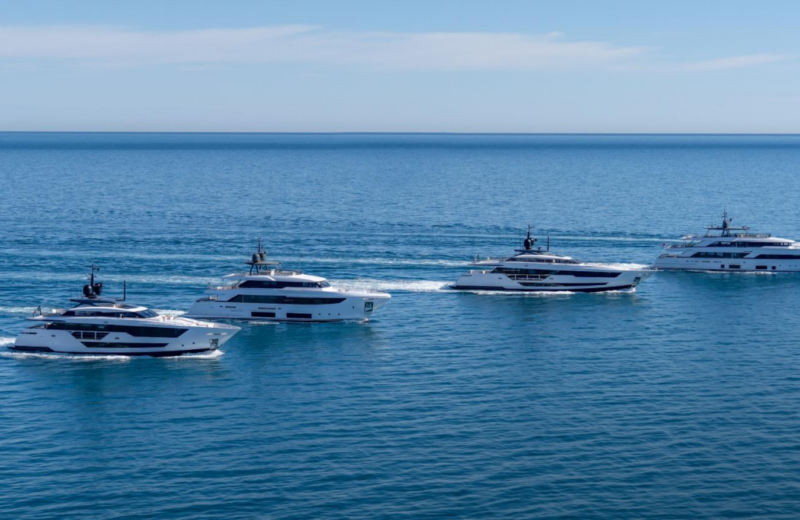The Italian job – building in a boom

“Batti il ferro finché è caldo” is an Italian saying that translates as “strike the iron while it’s hot.” And it’s one that rings true for Italian shipbuilding giants recently reporting strong growth for the first nine months of this year.
The economic turbulence hasn’t deterred superyacht buyers. In fact, shipyards’ revenue and backlogs continued to grow in the third quarter (Q3). The superyacht boom is rolling on – but are there signs of it coming to an end?
“The market remains in a strong position today from our experience,” Sam Cook, head of Specialty Lending, EMEA J.P. Morgan Private Bank tells Superyacht Investor.
“Whilst the level of enquiries has reduced from the post-lockdown highs, we continue to see a material number of our clients considering a yacht purchase or enquiring about yacht financing across the globe, especially in North America.”
Look no further than San Lorenzo’s Superyacht Division for proof. It brought in €138.4m ($142.9) of revenue in the first nine months of this year and made a pre-tax profit of €73.4m ($75.4) – up 43.1% compared with the same period in 2021. San Lorenzo says this was led by its Steel Line, which ranges from 52m (170ft) up to 72m (232ft) and the new X-Space explorer yacht range.
The Ferretti Group (fleet pictured) also reported an increase in superyacht sales up to €72.5m ($74.9m) from €56.2m, accounting for 9.3% of total revenue so far this year. In the third quarter alone, the group made €401m in revenue from new build yachts.
Superyacht sales for TISG accounted for €185.7m ($192m) this year, an increase of 67.7% compared with 2021. Company CEO, Giovanni Constantino, said that these figures have been bolstered by two sales of two Admiral Panorama 50m (164ft) yachts in the third quarter.
The growing backlogs are another positive for these shipyards too. San Lorenzo reported a record backlog of a cool €1.7bn as of September 30th, 2022.
“Significant backlogs provide certainty of deliveries, cashflow over a longer period, the lifeblood of a shipyard and don’t forget the repeat customers,” says Cook of Speciality Lending at J.P. Morgan.
TISG’s order book stands at €983m with 35 yachts currently under construction, 19 of which are over 50m (164ft). Ferretti Group also has an order book of €1.04bn, up 26.9% from the first nine months of 2021.
Cook says it is a good sign for the industry as a whole. “The more the fleet grows the more all stakeholders within the industry – suppliers, yacht managers, re-fit yards, etc – will benefit.”
However, the large order books do not come without challenges and some fear that may result in unsustainable increases in production across the shipyards.
“Parallels can be drawn to the private aviation market which experienced a significant increase in demand prior to the 2008 Financial Crisis, with supply following suit,” says Cook.
Whilst Cook does not anticipate a similar environment for superyachts, he emphasises the importance of shipyards growing at a sustainable level. Recent announcements from major technology companies show the challenges of growing too quickly.
“My view of whether the current level of growth is sustainable is that it is not,” he says. “The yachting industry can continue to grow from here, but at a lower more sustainable level.”
There are also fears that whilst the market currently appears to be strong, rising interest rates will eventually affect demand. “Increased volatility in financial markets will unquestionably have an impact on confidence levels and willingness to spend, even amongst the UHNWI segment,” says Cook.
According to Cook, a final factor which may slow growth is the ability of shipyards to react quickly to any further increases in demand. The production of superyachts can take up to five years, so shipyards’ ability to grow their production capacity is limited.
“This is even more true with the continued disruption to supply chains that many businesses are facing. Some economies continue to be impacted by Covid lockdowns as well as the impact of the inflationary environment,” he says.
Over the next 12 months, Cook predicts transaction volumes and prices will revert to a “new normal” – above 2019 levels but below the level of last year. A sign of this is the recent decrease in price for superyachts seen by the industry post-show season.
But, on balance, Cook reads this as a sign of a return to a normal functioning yacht market. “As we go forward, I believe the key consideration will be how the economic environment evolves and the resultant change in confidence levels amongst yacht users and buyers.”
Subscribe to our free newsletter
For more opinions from Superyacht Investor, subscribe to our email newsletter.

